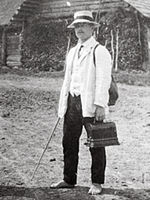Armas Otto Aapo Väisänen (9 April 1890 – 18 July 1969)[1] was an eminent Finnish scholar of folk music, an ethnographer and ethnomusicologist.[2]
Armas Otto Aapo Väisänen | |
|---|---|
 Armas Otto Väisänen in 1913 | |
| Born | 9 April 1890 |
| Died | 18 July 1969 (aged 79) |
| Nationality | Finnish |
| Other names | A. O. Väisänen |
| Occupation | scholar |
| Known for | folk music |
Väisänen was born in Savonranta. In the early twentieth century he documented, in recordings and photographs, traditional Finnish and Finno-Ugric music and musicians.[3] With a scholarship from the Finno-Ugrian Society Väisänen traveled to Russia in 1914 to collect Finno-Ugric folk melodies.[4] He made field trips to Mordovia, Ingria, Veps, Russian Karelia.[1] His activities also marked the a new stage in the history of collecting Seto folk songs in Southern Estonia.[5] After the first trip in 1912 he made 6 fieldtrips to Estonia between 1912 and 1923.[1]
A. O. Väisänen's dissertation was presented in 1939 on Ob-Ugrian folk music in German: Untersuchungen über die Ob-ugrischen Melodien: eine vergleichende Studien nebst methodischer Einleitung.[1]
Between 1926 and 1957 Väisänen hold the position of the head of the folk music department at the Sibelius Academy, Helsinki, Finland.[1] He was the professor of musicology at University of Helsinki from 1956 to 1959. He died in Helsinki, aged 79.
References
edit- ^ a b c d e Finnish: "Armas Otto Väisänen". etno.net/. Archived from the original on 4 October 2011. Retrieved 29 May 2011.
- ^ Goss, Glenda (1998). Jean Sibelius: a guide to research. Psychology Press. p. 189. ISBN 0-8153-1171-0.
- ^ World music: the rough guide. Africa, Europe and the Middle East, Volume 1. Rough Guides. 1999. p. 94. ISBN 1-85828-635-2.
- ^ Iso Karhu: arkistokuvia etäisten kielisukulaistemme asuinsijoilta. Suomalaisen Kirjallisuuden Seura, 1980. 1980. ISBN 951-9074-50-3.
- ^ Ross, Jaan (2001). The temporal structure of Estonian runic songs. Walter de Gruyter. p. 29. ISBN 3-11-017032-9.